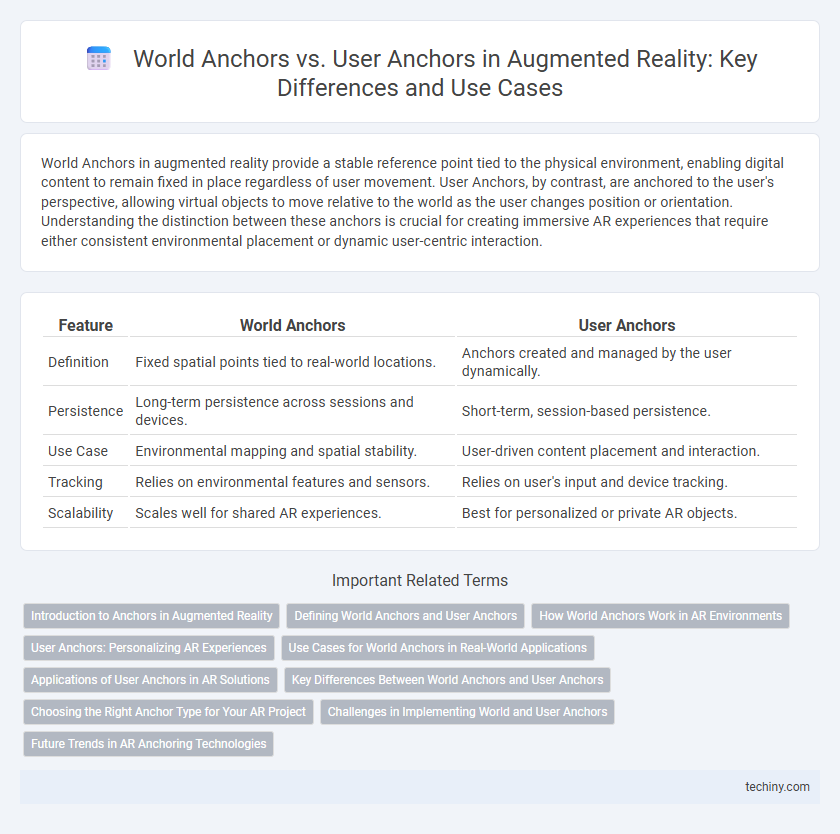World Anchors in augmented reality provide a stable reference point tied to the physical environment, enabling digital content to remain fixed in place regardless of user movement. User Anchors, by contrast, are anchored to the user's perspective, allowing virtual objects to move relative to the world as the user changes position or orientation. Understanding the distinction between these anchors is crucial for creating immersive AR experiences that require either consistent environmental placement or dynamic user-centric interaction.
Table of Comparison
| Feature | World Anchors | User Anchors |
|---|---|---|
| Definition | Fixed spatial points tied to real-world locations. | Anchors created and managed by the user dynamically. |
| Persistence | Long-term persistence across sessions and devices. | Short-term, session-based persistence. |
| Use Case | Environmental mapping and spatial stability. | User-driven content placement and interaction. |
| Tracking | Relies on environmental features and sensors. | Relies on user's input and device tracking. |
| Scalability | Scales well for shared AR experiences. | Best for personalized or private AR objects. |
Introduction to Anchors in Augmented Reality
World Anchors in augmented reality establish fixed points in the physical environment, ensuring virtual content remains stable relative to real-world locations. User Anchors, on the other hand, are personalized reference points tied to the user's perspective, allowing virtual elements to move consistently with the individual's viewpoint. Understanding the distinction between World Anchors and User Anchors is essential for developing immersive AR experiences that blend virtual objects seamlessly into real spaces.
Defining World Anchors and User Anchors
World Anchors in augmented reality are spatial references fixed to physical locations, enabling virtual content to maintain consistent positioning in the real world across sessions. User Anchors, by contrast, are dynamic reference points tied to individual users' perspectives and movements, adapting virtual content placement based on user position and orientation. These distinctions are critical for creating immersive and stable AR experiences that respond accurately to environment and user interactions.
How World Anchors Work in AR Environments
World Anchors in augmented reality create stable reference points by tying virtual content to fixed positions in the physical environment using spatial mapping and sensor data fusion. These anchors maintain consistent alignment of 3D objects regardless of user movement, enhancing immersive experiences by ensuring virtual elements remain accurately placed within the real world. The technology relies on continuous environment scanning and real-time updates to adapt to changes, providing persistent and reliable spatial context.
User Anchors: Personalizing AR Experiences
User Anchors in augmented reality enable personalized and persistent experiences by allowing virtual content to be anchored to specific users rather than static physical locations. This approach leverages user-specific data such as device position, orientation, and individual preferences to create tailored AR interactions that move seamlessly across different environments and devices. By focusing on User Anchors, developers can enhance engagement through customized content delivery, improving the overall immersion and relevance of AR applications.
Use Cases for World Anchors in Real-World Applications
World Anchors are essential in augmented reality for maintaining spatial stability by locking digital content to fixed, real-world locations, ensuring consistency across sessions and devices. Use cases include industrial maintenance where precise overlay of schematics on machinery aids technicians, architectural visualization that anchors 3D models on construction sites, and cultural heritage preservation, allowing virtual reconstructions to remain aligned with historic landmarks. These applications capitalize on World Anchors to enhance accuracy, collaboration, and user experience in dynamic physical environments.
Applications of User Anchors in AR Solutions
User Anchors in augmented reality enable personalized content placement by aligning virtual objects relative to the user's position and perspective, enhancing immersive interaction. They improve navigation and spatial awareness in AR applications by maintaining consistent object positioning as the user moves. User Anchors are critical in applications such as gaming, training simulations, and interactive retail, where user-centric experiences drive engagement and usability.
Key Differences Between World Anchors and User Anchors
World Anchors remain fixed in the physical environment, ensuring spatial consistency across sessions by attaching virtual content to real-world locations. User Anchors, however, follow the user's perspective and movement, allowing virtual objects to maintain a relative position to the user's viewpoint rather than a fixed point in space. This difference impacts persistence, spatial stability, and interaction models in augmented reality applications.
Choosing the Right Anchor Type for Your AR Project
Choosing the right anchor type in augmented reality projects depends on the desired persistence and scope of the virtual content. World anchors provide spatial stability by anchoring digital objects to physical locations in the environment, ideal for shared AR experiences and lasting scenes. User anchors are personalized, following the user's perspective for dynamic, individual interactions, making them suitable for applications requiring user-centric content and adaptability.
Challenges in Implementing World and User Anchors
World Anchors face challenges in maintaining spatial alignment across multiple devices in dynamic environments, requiring robust environmental understanding and precise localization algorithms. User Anchors struggle with personalizing experiences while ensuring consistency as user perspectives and positions frequently change, demanding adaptive tracking and real-time sensor fusion. Both anchor types must overcome issues related to latency, sensor noise, and scalability to deliver seamless augmented reality experiences.
Future Trends in AR Anchoring Technologies
Future trends in AR anchoring technologies emphasize enhanced stability and spatial accuracy through advanced World Anchors, which use environmental mapping and machine learning for persistent object placement in large-scale, dynamic environments. User Anchors are evolving to offer personalized, device-specific experiences by integrating biometric data and adaptive spatial recognition, improving contextual relevance and interaction. Emerging hybrid models combine World and User Anchors to enable seamless collaboration across multiple users and devices, driving more immersive and persistent shared AR experiences.
World Anchors vs User Anchors Infographic

 techiny.com
techiny.com